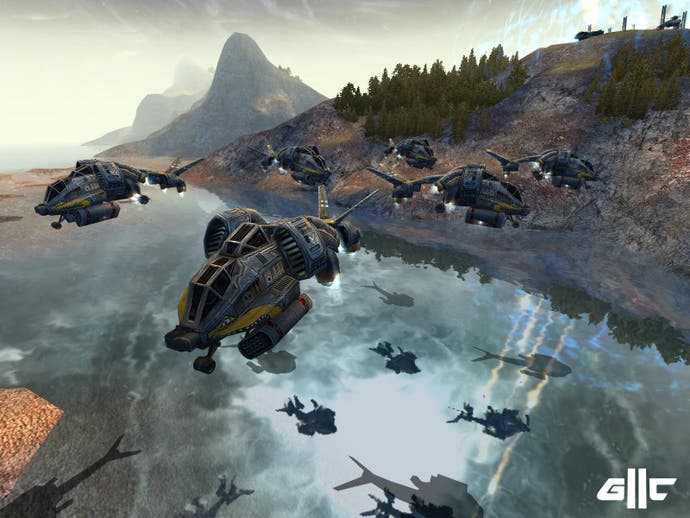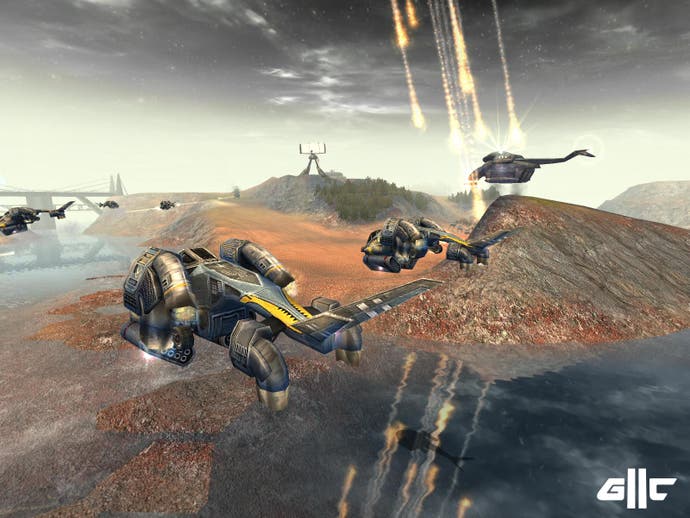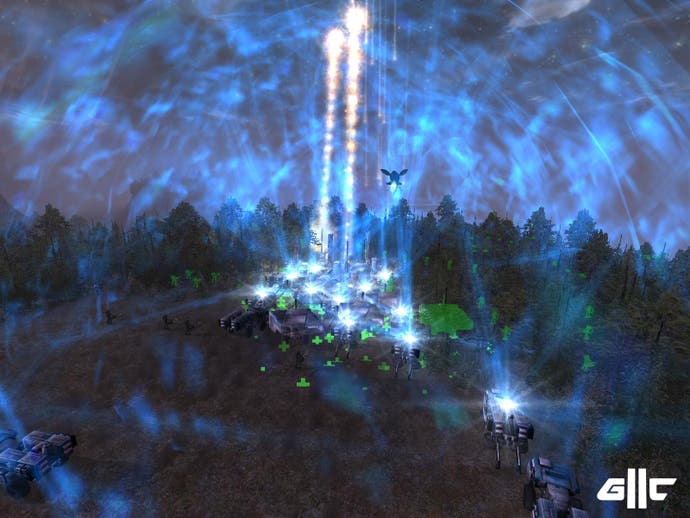Ground Control 2: Operation Exodus
This is Major Tom to Ground Control. I'm stepping through the door, and I'm dabbling in a most-a peculiar gaaaame...
Shop for games now with Simply Games.
It's a bit of a generalisation, but you could probably make a strong argument that says that PC gaming moves through a cycle of two distinct phases. You go from real-time strategy games to first-person shooter games, then back to strategy and back to shooters once more - a cycle which has continued, in some form at least, since id incubated Wolfenstein and Westwood dreamt of Dune 2.
At the moment, we're very much on the first-person shooter end of that cycle. They're not quite here yet, but Doom III, Half-Life 2 and, god knows, perhaps even Duke Nukem Forever (ha!) are on their way, restoring the FPS game to prominence in the PC market after a few barren years which saw some pretty rubbish shoot-'em-ups being utterly eclipsed by the likes of WarCraft III, Age of Mythology, Rise of Nations, Medieval: Total War... Oh, all right then, and possibly even Command & Conquer: Generals, if you like that sort of thing.
Command! Dominate! Control!

That's not to say that armchair generals don't have a few cracking games to look forward to on the PC this year. There's Rome: Total War, for a start, the very sight of which is enough to get any budding centurion looking uncomfortable about his tented toga. And then there's today's subject, a sequel to the cult hit Ground Control, which we dub a "cult hit" because while it didn't make a huge impact commercially, many of those who bought it did play it religiously for months online, and it's generally held in very high regard by strategy and tactics aficionados. After a few years at the grindstone, the Massive boys and girls (we're not being pass-remarkable, that's the name of the company) have turned out a sibling - and based on looks alone, it's a bit of a stunner.
The Ground Control concept is designed to distil strategy down to a very fundamental level; there's no base building, no unit manufacturing, and no resource management. What you can do is call down reinforcements from a dropship, which ferries them over from your base to a designated drop point (which you must hold securely at that point, otherwise the dropship can't land), and these reinforcements are purchased using points accumulated by holding "victory locations" on the map or destroying enemy troops. But, you get far less points if your standing army is very large, so the game encourages you to use small forces as effectively as possible.
The plot is pretty interesting sci-fi fare. You are Captain Jacob Angelus, an officer in the NSA forces who can't work out if he's English or Australian (well, his voice actor can't anyway), tasked with defending your home planet of Morningstar from the evil invading Imperial forces. The game throws in a number of other key characters - some of whom, like Lieutenant La Croix (who can't work out if she's French or American) and Major Grant (who's pretty certain he's from Texas, and is determined to make sure everyone knows it), you'll actually fight alongside on the battlefield as AI characters who command their own forces, while others simply appear in cut-scenes. Amusing accent confusion aside, the voice acting is solid, the script largely well written, and the whole thing holds the single-player game together very well indeed.
On a clear day...

Slick presentation and storyline aside, however, the first thing that you'll notice when you start playing Ground Control 2 is something that will smack you right in the retinas; this game is absolutely stunningly gorgeous to look at, with certainly the best graphics we've ever seen in a strategy title (the as-yet unreleased Rome aside). The technology underlying the game's visuals is unquestionably excellent; reflections ripple off bodies of water, individual troopers' faces can be seen glancing around behind the glass of their helmets, city tower blocks actually have furniture visible through their blown-out windows. It's also a surprisingly good performer even on medium specification systems, which was a pleasant surprise; we played the game perfectly happily on an Athlon XP 1700+ system with a GeForce 4 Ti4600.
As much as the technology, however, the art direction of the game deserves commendation for creating this sumptuous eye-candy treat. From the huge planets which hang overhead cloaked in glittering ring belts (and reflected in the water, which is a pretty dramatic looking effect) to the sheer range of different environments and weather effects on show, care has been lavished over every element of how the game looks - setting the stage for some stunning battles where explosions, tracer bullets, rocket trails, burnt-out vehicles and particle weapon effects all contribute to the mayhem.
The audio in the game is also well put together, with some decent backing music tracks (veering towards the rock end of the spectrum rather than the orchestral sound you normally find in strategy titles) and, as previously mentioned, fairly competent voice acting. The game also exploits the audio from engine noise and weapons fire very well, applying some clever logic to it so that what sounds like a rattle of fire from halfway across the map becomes a very visceral, booming sound if you immerse the camera in the middle of it. Panning across a battlefield works well for this reason; as you roll past choppers, tanks, infantry and so on, all with their distinct sound to add to the whole auditory landscape. Er... Did I really just say auditory landscape? Sorry, came over a bit arty there. Won't happen again guv.
Super Troopers

There are two playable sides in Ground Control 2, namely the NSA (humans) and the Virons (bug-eyed aliens), while a third side, the Imperial forces, remains resolutely unplayable despite featuring heavily in the single-player game. The NSA are pretty much what you'd expect - you have a few classes of infantry, a light and heavy APC, a couple of different armoured assault vehicles, an assault helicopter and a transport copter, and that's pretty much your lot. Providing an interesting contrast are the Virons, who have the ability to merge their units together to form another unit - so for example, two rocket-type infantry can merge to become an effective long-range mortar unit, and then split again when required. It's quite a unique play mechanic, but Massive have done a good job of balancing the two sides regardless, and the single-player campaign - in which you play first as the NSA and then assume command of Viron forces - introduces you nicely to playing as both.
The single-player campaign itself is the high point of what the game has to offer, with a set of interesting and varied missions which should take you between half an hour and an hour each to complete. While some of them boil down to having to eradicate the enemy by capturing their landing zones, others will see you marshalling a retreat (er - "tactical withdrawal") from vastly superior enemy forces, or sneaking in to heavily armed enemy bases using stealth units. Even the lone wolf missions are well-designed and quite good fun, though, unlike their counterparts in most RTS titles, and we didn't encounter any particularly unpleasant missions in the single-player mode.
What we did encounter, however, were a few niggling limitations to the gameplay which became more apparent, and serious, in multiplayer. For a start, the AI in the game is only just passable. Enemy troops act intelligently enough in combat situations, but they're phenomenally stupid in terms of overall strategy, with the AI choosing to send wave after wave of expensive troops into obvious death traps, or piling troops up against dead ends because its route finding has given up. Enemies also have a bad habit of sitting still when being shot at from outside their range, which can make some missions which would otherwise be tough almost disappointingly easy. In skirmish mode, or in multiplayer with some AI players, these limitations become even more obvious.
Lights, Camera...

Unlike many reviewers, we didn't have any particular problem with the camera in Ground Control 2. Once you get used to using the middle mouse button to sweep it around as required, it quickly becomes second nature to find the most advantageous angle on the action. However, the camera does have a few silly bugs attached to it - such as its tendency to sink into gorges or other deep parts of the map and refuse to rise above them, which is intensely annoying if you're currently fighting a battle for control of a bridge over said gorge - and suddenly find yourself trying to coordinate the action by peering at a babbling brook and some structural supports about 300 feet below where your troops are getting slaughtered. Cut-scenes also have a bad habit of resetting your carefully positioned camera, which isn't very helpful.
What we did find somewhat awkward is the way that troops are controlled. Standard RTS controls abound - double click a unit to select nearby units of the same type, and hit ctrl+number to create a command group - but some of the controls in the game are less well implemented. Units mostly have two distinct modes which you can switch them between depending on their situation, such as the standard infantry troopers who can either fire an anti-infantry bullet weapon, or an anti-armour rocket, but cannot move while in rocket mode. This presents a problem because if you select a mixed group and tell them to move somewhere, those in rocket mode simply won't move, without warning you that they can't. It's all too easy to get halfway across a map and suddenly realise that you've left a bunch of infantry, snipers and other units stuck a kilometre back thanks to this quirk.
Formation control is another place where Ground Control 2 suffers a bit. You can move your selected units into a formation using a pop-up menu, but they don't hold formation particularly intelligently. There's no logic in there to make them hold ranks around weaker units, for example, and more annoyingly, they won't attempt to stay in formation while moving. The range of formations available is also somewhat limited; the ability to drag out the shape of a formation on the ground, like in Medieval: Total War, would not have gone amiss.
None of this is to say that GC2's basic gameplay isn't fun. It certainly is, and it's a lot more hands-on and tactical than many RTS titles manage. However, we were a little disappointed that many situations in the game are simply solved by brute force; a bit more care in the otherwise excellent level design could have left some very simple, elegant tactical solutions open to players, which would have been a distinct improvement to the game. This is a problem which is less evident in multiplayer, where playing against human opponents introduces a bit more strategy to the whole affair, but even there the nature of the maps can militate against anything other than the tank-rush approach.
Two to Tango

It's in multiplayer, in fact, that Ground Control 2 suddenly starts looking like a less attractive prospect. There's a competent match-making system called MassGate for arranging online games, and it's possible to play co-op as well as deathmatch-type engagements, but the entire multiplayer component feels rushed and badly thought out, and reveals holes in the basic gameplay which you simply don't notice when playing through the superbly crafted single-player campaign.
Multiplayer in Ground Control 2 is, sadly, dull. The standard multiplayer mode gives you only ten maps to choose from, each even less inspired than the former, and the game plays out in a pure deathmatch kind of way - with heavy fighting around the victory points and landing zones, and almost nothing happening in the vast swathes of territory around them. First mover advantage almost always translates into victory because of the way the scoring system works, although the game does at least intelligently fiddle the number of points available for reinforcements to some extent, allowing wining armies to become "overstretched" in defending their territory; that said, this would work an awful lot better if you didn't just have to defend the victory points and ignore the rest of the map entirely.
The real problem with the multiplayer is the ridiculously open plan, uninteresting maps on offer, and hopefully a community will form behind the game and use the built-in map editor to create some better ones. However, there are certain major issues with the most basic aspects of how the game works as well, and there's only so much entertainment to be had from the deathmatch game mode. A few additional game modes wouldn't have gone amiss - we found ourselves particularly pining for some kind of more coordinated gameplay where victory points had to be captured in order, moving play back and forth across the map like a tug of war, rather than focusing minor skirmishes on a few apparently randomly chosen locations.
The one nod of the head towards the need for more variety is the co-op mode, but this is sadly a botched implementation; while we'd expected to get to take on the roles occupied by AI allies on the various maps, and be given different mission objectives to fulfil, this isn't the case at all. Instead, you just get two players commanding a half-sized force each, and attempting to fulfil the same mission objectives - something of a pointless exercise.
Unfinished Symphony
Ground Control 2 is unmistakably a superb game in single-player. We missed some of the more intricate aspects of the original, and the ability to carry veteran troops forward between missions is a glaring omission, but despite a few niggling faults, it's still one of the best single-player RTS titles we've ever played, and is well worth the price of entry for that alone - almost certainly a nine out of ten title. Unfortunately, it feels like Massive were forced to rush the multiplayer component of the game; and with multiplayer being a major aspect of any RTS title, that's a pretty large flaw. It doesn't make Ground Control 2 into a bad game, but it certainly knocks a few points off its score - and the cynic in us wonders when a mission pack featuring improved multiplayer, and the ability to play as the Imperial forces (who seem the whole way through as though they should be playable), will be arriving on the shelves one day and demanding twenty quid of our money for features that were probably in the original game design.
Shop for games now with Simply Games.








